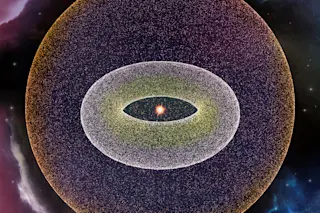The Oort cloud represents the very edges of our solar system. We know so little about it that its very existence is theoretical — the material that makes up this cloud has never been glimpsed by even our most powerful telescopes, except when some of it breaks free.
With limited direct observations and mostly theoretical models to guide our understanding, the Oort cloud presents a fascinating puzzle that holds the secrets of our solar system's origins.
(Credit: NASA/JPL-Caltech)
NASA/JPL-Caltech
The Oort cloud captivates the imaginations of scientists and space enthusiasts alike. The thinly dispersed collection of icy material starts roughly 200 times farther away from the sun than Pluto and stretches halfway to our sun’s nearest starry neighbor, Alpha Centauri.
It remains largely elusive, with its existence inferred from the occasional appearance of long-period comets.
The Oort cloud’s inner edge is believed to begin roughly 1,000 to 2,000 astronomical units ...















